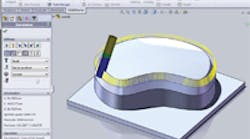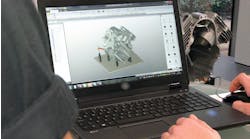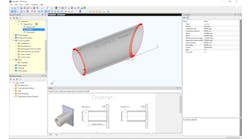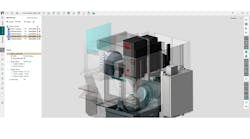What makes HSMWorks unique as a Computer Aided Manufacturing software package is that it was designed from the ground up to be fully integrated with SolidWorks 3D Computer Aided Design software and to take full advantage of the 64-bit multiprocessor technology that is available today.
Developed by HSMWorks ApS of Denmark, the HSMWorks package has been on the market for only two years, but it had been in development for much longer than that.
When multi-core microprocessors became available in 2002 and 64-bit architecture was just being released, the people at CIMCO Integration I/S in Denmark, who had been developing CNC programming, simulation, editing and communications software as well as other add-in technologies for machine tool manufacturers and CAM developers, wanted to develop software products that would take advantage of the increased capabilities the new technology offered. Those software developers had been working on add-in technologies since 1991.
The problem they ran into in designing the HSMWorks software was that all of the existing CAM kernels, the core of any CAM package, had limitations that made it very difficult to use the full potential offered by what was then the new 64-bit, dual-core microprocessor architecture.
Most of those existing kernels were developed for 16-bit architecture, then ported to 32-bit architecture, and their capabilities diminished further being ported to the new 64-bit architecture.
A new kernel designed specifically for 64-bit dual- or multi-core processors was needed.
Normally, CIMCO would have developed the new kernel, then offered it to its existing CAM development customers as an add-in product. However, the software developers realized that a new kernel was only half of what was needed to use the full potential of the latest computer technologies.
To maximize the benefits of the new technologies, the kernel had to be an organic part of the CAM system. Not something bolted onto an existing package.
Developing a complete CAM system was not part of CIMCO’s business plan, but the lure of the greatly increased performance that the new computer technologies offered was too strong to ignore. So the decision was made to spin off an entirely new company to develop and market a next generation solution.
The result was the creation of the HSMWorks software.
While the kernel is a critical part of any CAM package, so is the user interface and CAD functionality.
The developers looked at the user interfaces and functions of existing CAD packages and concluded that the SolidWorks package offered what was the perfect CAD/user interface and that the CAM function could be developed as an application module within SolidWorks. They call that realization their “Aha!” moment.
So development began along two tracks:
One was making a CAM application to run inside SolidWorks, the SolidWorks way because the developers felt it was a good template to use to design software.
The second track was to develop the kernel of the software.
Both product developments were bound tightly together with the HSMWorks CAM kernel designed to provide a robust technological foundation of capabilities and performance while taking into account the user experience and work flow that SolidWorks offered.
The result is a CAM package so completely integrated into SolidWorks that if it were not for the HSMWorks name appearing as one of the menu picks in the menu bar, end users would think they are just working with SolidWorks.
Based on end-user comments, HSMWorks does indeed achieve the greater potential offered by the 64-bit architecture, but it is still a work in progress.
Currently only milling and drilling functions are available. However, Anthony Graves, marketing director for HSMWorks, said a basic turning function is in beta testing, and is expected to be available later this year.
The package has solid 2-axis, 3-axis and 3+2-axis machining. The latest version of HSMWorks now supports 5-axis simultaneous swarf cutting and simultaneous 5-axis drilling will be released in February. Additional 5-axis strategies also are expected to be released later this year.
Graves said that, if a potential customer has an immediate need for full 5-axis simultaneous machining, he will refer them to other packages on the market.
The company’s immediate focus is on developing and optimizing 5-axis machining, and continuing to develop its reseller network. It does not have plans, at this time, to develop functions for multitasking machining.
Postprocessors from HSMWorks are Java-based and are fully editable by end users.
Graves noted that modifications to 2-axis and 3-axis postprocessors usually are minor edits that can be done by HSMWorks or its resellers at no cost during the evaluation period so that the software is ready to use as soon as the customer buys it. Customers who need customization of postprocessors for 5-axis machining will be charged a nominal fee. Graves said postprocessors are compiled on the fly, and are fast and clean – a benefit of using the new architecture.
He added that HSMWorks focuses on developing toolpaths that are optimized so they are the smoothest toolpaths possible. That results in reduced machining time, improved surface quality, less tool wear and extended tool life.
The package features innovative toolpath strategies such as Adaptive Clearing that combines a unique roughing strategy with side-cutting to keep a constant load on the tool and that typically reduces roughing time by 40 percent compared with standard roughing strategies. Graves said some customers report as much as an 80 percent reduction in machining time.
Among the benefits of using a package built to support multi-core processors and 64-bit speed is that these packages can benefit from multi-core systems by distributing tasks such as processing of single toolpaths across multiple cores and also multiple tasks can be shared across the processors for background processing, freeing the programmer to continue working on new toolpaths or other tasks. The 64-bit support offers the benefit of no RAM limitations found with 32-bit-based systems, allowing them to process larger toolpaths on larger parts without having to split the part into multiple pieces to generate the toolpaths.
The software includes full associativity, simulation, and solid simulation that allows the user to see the actual stock being removed from a solid block of material and to automatically check for shaft and clamp/fixture collision.
The package offers backplot and solid verification of the G-code, but Graves said that if a machine shop needs to verify complex 5-axis toolpaths or is using special workholding fixtures then the Vericut CAM package from CG Tech or the Virtual CNC CAM package from Predator should receive serious consideration.
HSMWorks is available either as a SolidWorks add-in or a standalone package under the HSMWorks name that includes SolidWorks parts, drawings and assemblies capabilities. Both options are available through a global network of resellers that cover North America, Europe, India and parts of Asia.
In today’s business climate, shops that are looking to add value to their products usually need to acquire and use 3D CAD software.
For shops that primarily do 2-axis, 3-axis or 3+2-axis machining, HSMWorks offers a unique and very powerful CAM package that is truly fully integrated with the SolidWorks 3D CAD package, and takes maximum advantage of the new 64-bit dual-core and multi-core technologies.
But HSMWorks also is a work-inprogress that currently lacks basic turning functions and has only limited 5-axis machining functions. Shops that need those functions immediately need to look at other CAM packages.
If a shop can wait, then HSMWorks’s effective use of the new computer technologies to create optimized, high-speed machining toolpaths may make the wait well worthwhile.






